Intellidex top ETF picks for Nov 2016
The five exchange-traded funds (ETFs) that Intellidex chooses as its picks each month are usually the best funds available in each of five different broad categories of investment strategies. Not all categories are appropriate for all investors – it depends on your personal circumstances – but the funds we pick are what we think are the best available in each category.
In this monthly note we review the performance of our preferred funds and consider the general investment outlook. Our review for this month sees a few changes to our recommended list to incorporate changes in the outlook for different asset classes. We have also added a sixth asset class, bonds & cash, which might be useful for some risk-averse clients who want cash-like returns.
The past year has been characterised by a low-growth macroeconomic environment and marked volatility in the foreign exchange market, largely due to speculation about interest rates in the United States and heightened geopolitical uncertainty in the US and Europe, as well as the obvious problems with our domestic politics. We anticipate that a number factors will continue to cause significant volatility on global markets in the short to medium term:
- US elections outcome
- Brexit developments
- US interest rates, with indications that a rate hike may occur before the end of the year
In addition, we have specific South African themes that are likely to keep the all share index under pressure and the rand volatile:
- A potential ratings downgrade
- Unsettling political developments
- A stagnant economy: in the recent mid-term budget, the treasury halved growth estimates to 0.5% for 2016.
- Trade balance: the most recent numbers from Stats SA show that we had a positive trade balance in September from a deficit in August. Overall, we are still in a deficit for the year although it is much better than last year.
Our view on appropriate ETFs incorporates the highly volatile local and global environment we are operating in.
We explain why we like these funds below, but here are our top funds for November:

Local equities
There are a range of funds which invest in local equities but we prefer those that track the performance of the top 40 index, which accounts for at least 80% of the JSE’s total market capitalisation. We have found these to have better diversification and still provide stable and superior returns over the long term.
Within this class we prefer the Swix-weighted funds because they have a relatively lower exposure to commodities. Although commodity prices recovered modestly during the year, resource counters climbed disproportionately, in some cases more than threefold. However, we don’t see a repeat of this performance in the short term because the commodities market remains lukewarm due to supply-demand dynamics.
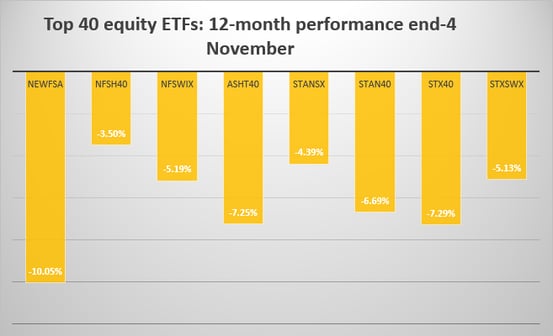
We like any of the three Swix-weighted top 40 funds (Satrix Swix, NewFunds Swix 40 or Stanlib Swix) but our favourite is the NewFunds Swix 40 ETF because it has maintained the lowest expense ratio relative to peers. However, the Newfunds Swix 40 has underperformed both its closest peers for the past year, registering a return of -5.19%, while the Stanlib Swix returned -4.39% and the Satrix Swix
-5.13%. All Swix-weighted funds performed better than non-Swix weighted top 40 funds. This performance is poor relative to other asset classes such as bonds and cash, but investors should note that equity investments are volatile and tend to outperform in the long run.
International equites
International markets are in limbo due to twin geopolitical factors: uncertainty surrounding the mechanics of Brexit, the UK’s process to leave the European Union, and the outcome of the US election. Should the once unthinkable happen and Donald Trump wins, we expect much short-term volatility. Brexit uncertainty is likely to keep dragging down both UK and European markets for longer. In the past we preferred the DBx World fund, but we think Brexit worries will adversely affect its UK and European exposures. The Japanese economy relies heavily on exports for growth so the DBx Japan ETF is likely to be hurt by waning global demand as well as the geopolitical issues mentioned above. We therefore change our preferred pick in favour of the DBx USA fund. This is 100% exposed to US equities. Ironically, in moments of severe uncertainty, US markets tend to benefit as risk averse investors consider it a safe haven. Given the difficult global environment and risks of seismic political shifts in the US, we think US assets will benefit disproportionately.
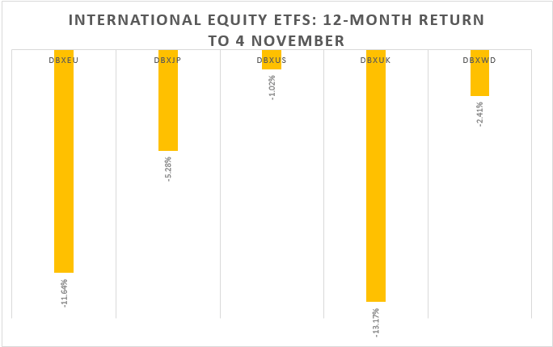
SA’s foreign-exposed funds traditionally derived the bulk of their return from forex movements. Since our review at the beginning of October, returns for all five DBx funds have come down sharply in line with the recovery of the rand against major currencies, as well as market volatility. DBx USA had a 12-month return of -1.02%, better than all its peers. The worst performer was the DBx UK fund at -13.17%.
Dividend-focused ETFs
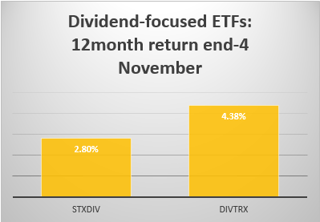 We believe returns should be considered on a total return basis rather than just looking at the income (dividend) return component. Whereas the Satrix Divi pools its assets from the top 40 index, the Coreshares Dividend Aristocrat ETF extends its pool to mid-caps. Although we prefer the Satrix Divi because it is forward-looking, based on projected dividends, it has underperformed its peers over the past 12 months, returning only 2.8% compared with 4.4% for the Coreshares ETF. A weakness with the CoreShares fund though is that it is based on historical performance that may not be repeated in future. Nevertheless we think the Satrix Divi is still the preferable option because of its forward-looking methodology.
We believe returns should be considered on a total return basis rather than just looking at the income (dividend) return component. Whereas the Satrix Divi pools its assets from the top 40 index, the Coreshares Dividend Aristocrat ETF extends its pool to mid-caps. Although we prefer the Satrix Divi because it is forward-looking, based on projected dividends, it has underperformed its peers over the past 12 months, returning only 2.8% compared with 4.4% for the Coreshares ETF. A weakness with the CoreShares fund though is that it is based on historical performance that may not be repeated in future. Nevertheless we think the Satrix Divi is still the preferable option because of its forward-looking methodology.
Property ETFs
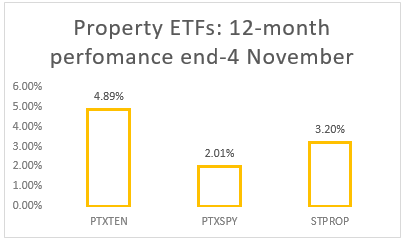 There are a few property-focused ETFs to choose from but our choice is the CoreShares PropTrax 10, which uses an equally weighted index that reduces the idiosyncratic risk of individual companies.
There are a few property-focused ETFs to choose from but our choice is the CoreShares PropTrax 10, which uses an equally weighted index that reduces the idiosyncratic risk of individual companies.
Property has been a pretty bright part of the JSE over the past few years but Brexit developments created uncertain prospects for companies with UK exposures. The CoreShares PropTrax 10 ETF has maintained its top performance within the segment, returning 4.9% (October review: 6.8%).
Diversified funds
Equities are regarded as the financial asset class that carries the most risk. They generally provide the best returns over time, which compensates for the high short-term risk, so they are more suited to longer-term investors.
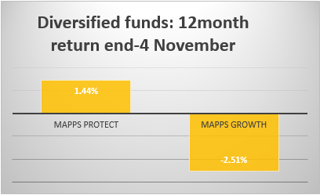 One way to lessen that risk is to invest in funds that include other asset classes such as bonds and cash. Two good funds for this are the NewFunds MAPPS Protect ETF and the NewFunds MAPPS Growth ETF. The funds are designed to meet two different risk appetites: Protect is suitable for older savers nearing retirement and Growth is for younger savers with a longer time horizon. MAPPS Growth returned -2.51% (October: 7.20%) while MAPPs Protect had a return of 1.44% (October: 7.23%) over the past 12 months.
One way to lessen that risk is to invest in funds that include other asset classes such as bonds and cash. Two good funds for this are the NewFunds MAPPS Protect ETF and the NewFunds MAPPS Growth ETF. The funds are designed to meet two different risk appetites: Protect is suitable for older savers nearing retirement and Growth is for younger savers with a longer time horizon. MAPPS Growth returned -2.51% (October: 7.20%) while MAPPs Protect had a return of 1.44% (October: 7.23%) over the past 12 months.
Bond and cash funds
All the funds described above are predominantly equity investments. However, bonds and cash have distinct risk properties which, when combined with equity investments, produce better risk-adjusted returns.
There are four listed funds in this category:
They each track different things: (i) tracks government bonds; (ii) & (iv) tracks inflation-linked government bonds; and (iii) tracks short-term money market instruments.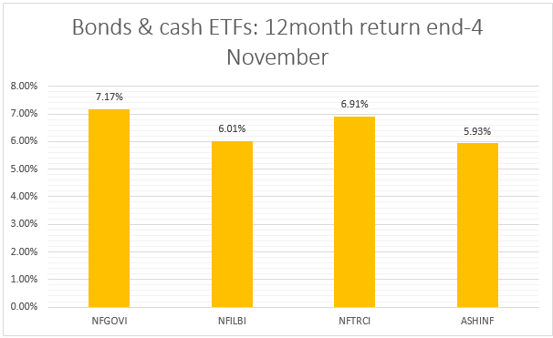
If you are investing for a very short period, usually less than a year, then we prefer the NewFunds TRACI 3 Month as it is the least sensitive to sudden adverse interest rate movements. This is as close to cash as you can get.
For a longer investment horizon, our preference is guided by caution, particularly in emerging markets where various external and internal variables can drive the inflation level up. So we would choose an inflation-linked bond to cushion investors for unseen inflation pressures. Because the NewFunds ILBI ETF has a lower expense ratio, it is our choice here. It has also marginally outperformed its alternative, returning 6.01% compared with 5.93%.
Disclaimer
This research report was issued by Intellidex (Pty) Ltd. Intellidex aims to deliver impartial and objective assessments of securities, companies or other subjects. This document is issued for information purposes only and is not an offer to purchase or sell investments or related financial instruments. Individuals should undertake their own analysis and/or seek professional advice based on their specific needs before purchasing or selling investments. The information contained in this report is based on sources that Intellidex believes to be reliable, but Intellidex makes no representations or warranties regarding the completeness, accuracy or reliability of any information, facts, estimates, forecasts or opinions contained in this document. The information, opinions, estimates, assumptions, target prices and forecasts could change at any time without prior notice. Intellidex is under no obligation to inform any recipient of this document of any such changes. Intellidex, its directors, officers, staff, agents or associates shall have no liability for any loss or damage of any nature arising from the use of this document.
Subscribe To Our Research Portal
Search all research
Let Us Help You, Help Yourself
From how-to’s to whos-whos you’ll find a bunch of interesting and helpful stuff in our collection of videos. Our knowledge base is jam packed with answers to all the questions you can think of.





